Wednesday, March 31. 2010
Why Greenpeace is Wrong about IT
Via WorldChanging
-----
by Alex Steffen
The cloud is growing at a time when climate change and reducing emissions from energy use is of paramount concern. With the growth of the cloud, however, comes an increasing demand for energy. For all of this content to be delivered to us in real time, virtual mountains of video, pictures and other data must be stored somewhere and be available for almost instantaneous access. That ‘somewhere’ is data centres - massive storage facilities that consume incredible amounts of energy.
Sounds scary, right?
Except when you actually look up the numbers. Computing accounts for a bit less than 3% of U.S. energy usage, according to Lawrence Livermore Labs. The global IT industry as a whole generates about 2% of global CO2 emissions.
Cars, on the other hand, which the vast majority of the people Greenpeace is trying to target also own, are the single largest contributor to climate change, according to NASA, exceeding all other sources in their impacts, and exceeding computing's global impacts by more than a factor of ten. Greenpeace (I'm a supporter) has made a lot of noise about computing's climate impacts, while the average commute or drive to the mall is likely far, far more a threat to the future than the average month's Google searching.
In fact, in some cases, that Google search can replace that trip to work or the mall. Technology can in fact greatly increase the efficiency of urban living, particularly car-free living in walkable neighborhoods as I wrote yesterday. Indeed, the same study Greenpeace is relying on finds that tech has as much capacity to cure as harm: "The Smart 2020 study also made a compelling case for ICT’s significant potential to deliver climate and energy solutions, estimating that ICT technologies could cut 7.8 GtCO2 of global greenhouse gas emissions by 2020, a 15% reduction over business-as-usual projections."
It may pull hits to call the iPad a planet killer, but worrying about the right thing is generally a good caution. If Greenpeace really wants to get up in people's grill about something that needs to change, it should start with their cars.
PS: I'm a supporter of Greenpeace. And yes, they've mentioned cars in the past. That said, the fact the word "car" doesn't even appear on Greenpeace USA's front page is telling.
UPDATE: Quick note. Just got into a bit of conversation about Greenpeace's talking point on this, that "if it were considered a country, our collective computing carbon footprint would place 5th in world for energy use." I think it's misleading, almost to the point of dishonesty.
Parse the statement:
1) if it were a country -- immediately, in order to be a fair comparison, we'd have to know something about the ranking of national emissions, which, as it turns out, is quite different than the structure of emissions sources, so immediately we're into an apples and oranges comparison, if for no other reason that there are 212 nations, but only a small number of categories emissions sources.
2) our collective -- intentionally vague, perhaps, but for this talking point to be even vaguely true, it has to mean "global" which sounds less out of whack.
3) 5th in the world for energy use -- I still don't see how that number stacks up, but even granting its correctness, there are two problems: a) 5th in the world naturally makes people draw the association that it's the 5th biggest source of CO2, and b) "for energy use" is a completely arbitrary line, drawn apparently just to make computers seem a bigger part of the problem.
To be clear, emissions from dirty energy use in ICT manufacture/use is roughly the same magnitude of problem as emissions from cement manufacturing, or air travel, or landfill methane, or coal fires and gas flares. It's a problem, one we should fix, but this campaign makes it seem like it ought to be one of our top priorities, rather than way down the list after dealing with massive society-wide problems like transportation/land use, buildings, forestry and agriculture.
It all goes back to the point I made earlier about Comparative Measurements and Knowing Our Facts, that clarity counts, and intentionally muddying the waters to score the most temporary of small victories (if even that) is bad strategy and ultimately counter-productive.
C'mon, Greenpeace: you're better than this!
Tuesday, March 30. 2010
Robotic Planes Chase After Climate Data
For the first time, NASA has begun flying an unmanned aircraft outfitted with scientific instruments to observe the Earth's atmosphere in greater detail. The agency has partnered with
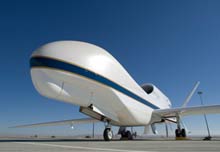 |
| Robo-plane: NASA and Northrop Grumman have developed this unmanned aircraft equipped with scientific instruments for earth science missions. Called Global Hawk, NASA acquired the airplane from the U.S Air Force and modified it to carry instruments to monitor the atmosphere more precisely than satellites can. Credit: NASA |
The Global Hawks' first mission launched last week--an aircraft flew from NASA's
"The first mission is mostly a demonstration mission to prove the capabilities of the system," says Paul Newman, co-project scientist and an atmospheric physicist at NASA Goddard Space Flight Center in Greenbelt, MD. The aircraft will also fly under the Aura Satellite, a NASA satellite currently studying the Earth's ozone, air quality, and climate, to validate its measurements, making a comparison between its readings and what the new aircraft can do. "Satellites give you global coverage every day, but they can't see a region very precisely. The aircraft can give you regular observations and very fine resolution," says Newman.
The robotic airplanes operate completely autonomously--scientists program the plane prior to departure with the intended destinations, and the plane navigates itself. However, scientists can change the aircraft's flight path once in route or remotely pilot it in an emergency. Because a Global Hawk flight can last 30 hours (compared to 12 hours for a manned flight), the aircraft can travel to regions, such as the arctic, that are typically too dangerous for manned missions.
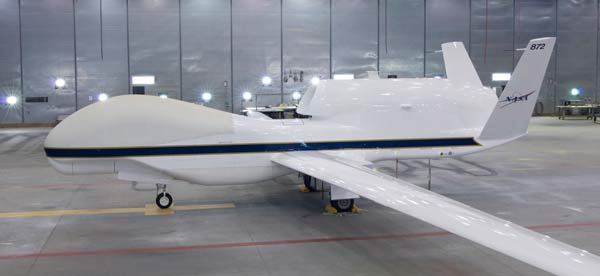 |
| Autonomous flier: The airplane’s first mission is to monitor the atmosphere above the Pacific Ocean. It can fly for up to 30 hours, reach an altitude of 19.8 kilometers, and travel a range of 22,800 kilometers. Credit: NASA |
NASA acquired the aircraft from the
The instruments onboard for the first mission include: a LIDAR instrument that uses a laser pulse to measure the shape, size, and density of clouds and aerosols; a spectrograph that measures and maps pollutants like nitrogen dioxide, ozone, and aerosols; an ultraviolet photometer for ozone measurements; a gas chromatograph to calculate
The researchers will also be able to sample parts of the atmosphere that they have not been able to reach or monitor for long durations--the upper troposphere and lower stratosphere. The aircraft can fly at an altitude of 19.812 kilometers and travel nearly 22,800 kilometers. That part of the atmosphere is "a crucial region that responds to and contributes to climate change at the surface, and we have come to realize that it is highly undersampled," says David Fahey, a research physicist at NOAA's Earth Science Research Lab in Boulder, CO. "If
NASA and Northrop Grumman modified the aircraft to be a plug-in-play system, so that instruments can be easily taken off and new ones installed, depending on the mission. The plane can also be redesigned for a specific mission, if necessary.
"The planes are really robotic satellite-aircraft hybrids that are going to revolutionize the way we do science," Newman says. The next mission will be to study hurricanes in the Caribbean, and will include a new suite of instruments for the planes.
Copyright
Monday, March 29. 2010
The Spatial Mind

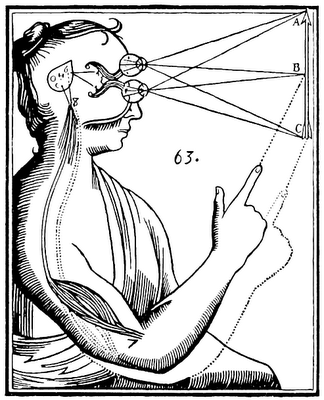
Supermodel
Via BLDGBLOG
-----
by noreply@blogger.com (Geoff Manaugh)
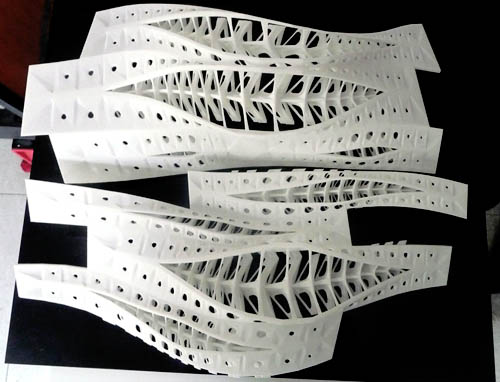 [Image: Thesis project by Vincenzo Reale, from a course taught by Alessio Erioli at the University of Bologna; photo by Alessio Erioli].
[Image: Thesis project by Vincenzo Reale, from a course taught by Alessio Erioli at the University of Bologna; photo by Alessio Erioli].Here are two 3D-printed thesis projects from a course taught by Alessio Erioli at the University of Bologna; above you see work by Vincenzo Reale, below work by Riccardo La Magna. I have to admit to being utterly blown away by the formal possibilities of 3D printers, and these projects only make that obsession more extreme.
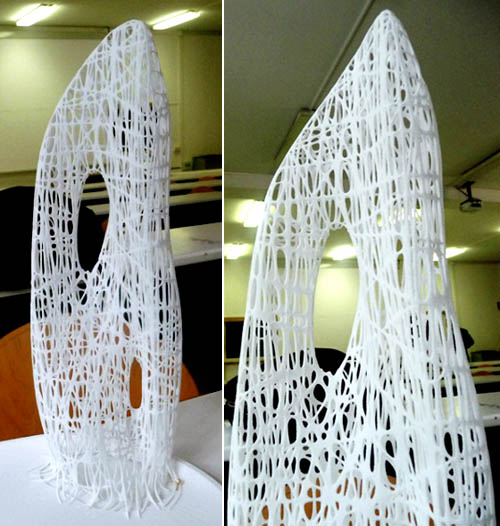 [Image: Thesis project by Riccardo La Magna, from a course taught by Alessio Erioli at the University of Bologna; photo by Alessio Erioli].
[Image: Thesis project by Riccardo La Magna, from a course taught by Alessio Erioli at the University of Bologna; photo by Alessio Erioli].For one or two more images of these and other thesis projects, check out the Flickr stream of Alessio Erioli, where I originally saw these photos; for more on the future of (an admittedly different kind of) 3D printing, check out the recent, awesome article by Tim Abrahams in Blueprint Magazine: "In a small shed on an industrial park near Pisa is a machine that can print buildings," we read.
- The machine itself looks like a prototype for the automotive industry. Four columns independently support a frame with a single armature on it. Driven by CAD software installed on a dust-covered computer terminal, the armature moves just millimetres above a pile of sand, expressing a magnesium-based solution from hundreds of nozzles on its lower side. It makes four passes... The system deposits the sand and then inorganic binding ink. The exercise is repeated. The millennia-long process of laying down sedimentary rock is accelerated into a day. A building emerges. This machine could be used to construct anything.
Wednesday, March 24. 2010
President time?
Related Links:
Personal comment:
This picture taken from a GOOD blog article made me wonder. Not for it's content (Barack Obama and Hillary Clinton congratulating themselves, possibly after the acceptance of the new health insurance policy?), nor for the fact that the picture seems to be taken in a video conference room (less air travel?, this link too about the same subject, by John Thackara) but for the clock on the left of the picture!
Does the president have it's own time? It's very intersting to see that there is the indication of local time, president time and zulu (?! ;)) time! Due to it's constant travel, it's possible that the president remains in its own time zone if he travels constantly and doesn't stay for a long period in a distant country.
We should present him our open source I-Weather metabolic climate and timing for deterritorialized people!
fabric | rblg
This blog is the survey website of fabric | ch - studio for architecture, interaction and research.
We curate and reblog articles, researches, writings, exhibitions and projects that we notice and find interesting during our everyday practice and readings.
Most articles concern the intertwined fields of architecture, territory, art, interaction design, thinking and science. From time to time, we also publish documentation about our own work and research, immersed among these related resources and inspirations.
This website is used by fabric | ch as archive, references and resources. It is shared with all those interested in the same topics as we are, in the hope that they will also find valuable references and content in it.

